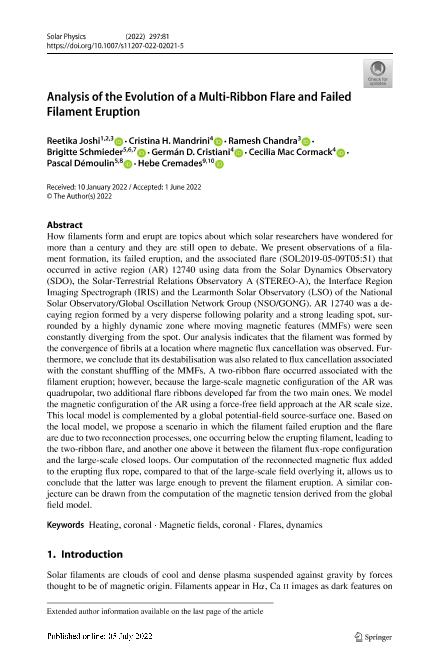Artículo
Analysis of the Evolution of a Multi-Ribbon Flare and Failed Filament Eruption
Joshi, Reetika; Mandrini, Cristina Hemilse ; Chandra, Ramesh; Schmieder, Brigitte; Cristiani, Germán Diego
; Chandra, Ramesh; Schmieder, Brigitte; Cristiani, Germán Diego ; Mac Cormack, Cecilia
; Mac Cormack, Cecilia ; Démoulin, Pascal; Cremades Fernandez, Maria Hebe
; Démoulin, Pascal; Cremades Fernandez, Maria Hebe
 ; Chandra, Ramesh; Schmieder, Brigitte; Cristiani, Germán Diego
; Chandra, Ramesh; Schmieder, Brigitte; Cristiani, Germán Diego ; Mac Cormack, Cecilia
; Mac Cormack, Cecilia ; Démoulin, Pascal; Cremades Fernandez, Maria Hebe
; Démoulin, Pascal; Cremades Fernandez, Maria Hebe
Fecha de publicación:
06/2022
Editorial:
Springer
Revista:
Solar Physics
ISSN:
0038-0938
Idioma:
Inglés
Tipo de recurso:
Artículo publicado
Clasificación temática:
Resumen
How filaments form and erupt are topics about which solar researchers have wondered for more than a century and they are still open to debate. We present observations of a filament formation, its failed eruption, and the associated flare (SOL2019-05-09T05:51) that occurred in active region (AR) 12740 using data from the Solar Dynamics Observatory (SDO), the Solar-Terrestrial Relations Observatory A (STEREO-A), the Interface Region Imaging Spectrograph (IRIS) and the Learmonth Solar Observatory (LSO) of the National Solar Observatory/Global Oscillation Network Group (NSO/GONG). AR 12740 was a decaying region formed by a very disperse following polarity and a strong leading spot, surrounded by a highly dynamic zone where moving magnetic features (MMFs) were seen constantly diverging from the spot. Our analysis indicates that the filament was formed by the convergence of fibrils at a location where magnetic flux cancellation was observed. Furthermore, we conclude that its destabilisation was also related to flux cancellation associated with the constant shuffling of the MMFs. A two-ribbon flare occurred associated with the filament eruption; however, because the large-scale magnetic configuration of the AR was quadrupolar, two additional flare ribbons developed far from the two main ones. We model the magnetic configuration of the AR using a force-free field approach at the AR scale size. This local model is complemented by a global potential-field source-surface one. Based on the local model, we propose a scenario in which the filament failed eruption and the flare are due to two reconnection processes, one occurring below the erupting filament, leading to the two-ribbon flare, and another one above it between the filament flux-rope configuration and the large-scale closed loops. Our computation of the reconnected magnetic flux added to the erupting flux rope, compared to that of the large-scale field overlying it, allows us to conclude that the latter was large enough to prevent the filament eruption. A similar conjecture can be drawn from the computation of the magnetic tension derived from the global field model.
Palabras clave:
FLARES, DYNAMICS
,
HEATING, CORONAL
,
MAGNETIC FIELDS, CORONAL
Archivos asociados
Licencia
Identificadores
Colecciones
Articulos(CCT - MENDOZA)
Articulos de CTRO.CIENTIFICO TECNOL.CONICET - MENDOZA
Articulos de CTRO.CIENTIFICO TECNOL.CONICET - MENDOZA
Citación
Joshi, Reetika; Mandrini, Cristina Hemilse; Chandra, Ramesh; Schmieder, Brigitte; Cristiani, Germán Diego; et al.; Analysis of the Evolution of a Multi-Ribbon Flare and Failed Filament Eruption; Springer; Solar Physics; 297; 7; 6-2022; 1-29
Compartir
Altmétricas



